Numerical Analysis to the Effect of Guiding Plate on Flow Characteristics in a Ball Valve
Abstract
:1. Introduction
2. Simulation Calculation
2.1. Computational Domain
2.2. Boundary Conditions
2.3. Computational Grids
2.4. Mesh Independence Verification
2.5. Simulation Accuracy Verification
3. Results and Discussion
3.1. Flow and Resistance Coefficient
3.2. Velocity Distribution of Valve Internal Flow
3.3. Velocity and Pressure Distribution in the Valve with Three Guiding Plates
3.4. Velocity Distribution Downstream of Valve
4. Conclusions
- (1)
- By comparing the flow and resistance coefficients of the valves without guiding plates and with guiding plates, the guiding plate can decrease the flow coefficient obviously, but will have a slight effect on the resistance coefficient.
- (2)
- The guiding plate can modify the gap flow between the valve core and the valve wall in the top of the valve. When three guiding plates are used, most flows move through the holes on the guiding plate. The plate at the downstream blocks the whole gap, thus avoiding the generation of the gap jet flow, and improves the flow stability of downstream of valve ultimately. High-speed jet flows occur downstream of the guiding plate, which alleviates the erosion of the core and the wall.
- (3)
- The guiding plate plays a significantly important role in separating the flow and the holes on guiding plate provide drainage. Compared to the valve without guiding plates, the flow distribution in the valve with guiding plate is much more uniform, which reduces the internal erosion and stabilizes the downstream flow of the valve, particularly when the valve opening degree is small, when the effect is more noticeable. The present studies have practical significance for designing a ball valve. By adding the guiding plate, the downstream flows of the valve core are stabilized, and the erosion of the valve core and wall surface is reduced as well, which increases the lifetime of the ball valve and working stability of the pipeline system.
Author Contributions
Funding
Acknowledgments
Conflicts of Interest
References
- Li, X.J.; Chen, B.; Luo, X.W.; Zhu, Z.C. Effects of flow pattern on hydraulic performance and energy conversion characterization in a centrifugal pump. Renew. Energy 2019. [Google Scholar] [CrossRef]
- Pei, J.; Osman, M.K.; Wang, W.J.; Yuan, J.P.; Yin, T.Y.; Appiah, D. Unsteady flow characteristics and cavitation prediction in the double-suction centrifugal pump using a novel approach. Proc. Inst. Mech. Eng. Part A J. Power Energy 2019. [Google Scholar] [CrossRef]
- Bai, L.; Zhou, L.; Han, C.; Zhu, Y.; Shi, W.D. Numerical study of pressure fluctuation and unsteady flow in a centrifugal pump. Processes 2019, 7, 354. [Google Scholar] [CrossRef] [Green Version]
- Wang, C.; Chen, X.X.; Qiu, N.; Zhu, Y.; Shi, W.D. Numerical and experimental study on the pressure fluctuation, vibration and noise of multistage pump with radial diffuser. J. Braz. Soc. Mech. Sci. 2018, 481. [Google Scholar] [CrossRef]
- Wang, C.; He, X.K.; Shi, W.D.; Wang, X.K.; Wang, X.L.; Qiu, N. Numerical study on pressure fluctuation of a multistage centrifugal pump based on whole flow field. AIP Adv. 2019, 9, 035118. [Google Scholar] [CrossRef] [Green Version]
- Pei, J.; Zhang, F.; Appiah, D.; Hu, B.; Yuan, S.Q.; Chen, K.; Asomani, S.N. Performance prediction based on effects of wrapping angle of a side channel pump. Energies 2019, 12, 139. [Google Scholar] [CrossRef] [Green Version]
- Liu, Q.; Ye, J.H.; Zhang, G.; Xu, H.G.; Jin, H.Z.; Zhu, Z.C. Study on the metrological performance of a swirlmeter affected by flow regulation with a sleeve valve. Flow Meas. Instrum. 2019, 67. [Google Scholar] [CrossRef]
- Liu, Q.; Ye, J.H.; Zhang, G.; Lin, Z.; Xu, H.G.; Zhu, Z.C. Metrological performance investigation of swirl flowmeter affected by vortex inflow. J. Mech. Sci. Tech. 2019, 33, 1–10. [Google Scholar] [CrossRef]
- Li, Y.; Zhang, H.B.; Lin, Z.; He, Z.H.; Xiang, J.L.; Xiang, X.H. Relationship between wear formation and large-particle motion in a pipe bend. R. Soc. Open Sci. 2019, 6, 181254. [Google Scholar] [CrossRef] [Green Version]
- Yang, H.; Zhang, W.; Zhu, Z.C. Unsteady mixed convection in a square enclosure with an inner cylinder rotating in a bi-directional and time-periodic mode. Int. J. Heat Mass. Tran. 2019, 136, 563–580. [Google Scholar] [CrossRef]
- Zhang, W.; Li, X.J.; Zhu, Z.C. Quantification of wake unsteadiness for low-Re flow across two staggered cylinders. Proc. Inst. Mech. Eng. Part C J. Mech. Eng. Sci. 2019, 233, 6892–6909. [Google Scholar] [CrossRef]
- Li, S.J.; Deng, S.; Zhao, L.; Zhao, R.K.; Lin, M.; Du, Y.P.; Lian, Y.H. Mathematical modeling and numerical investigation of carbon capture by adsorption: Literature review and case study. Appl. Energy 2018, 221, 437–449. [Google Scholar] [CrossRef]
- Li, X.J.; Li, B.W.; Yu B., X.; Ren, Y.; Chen, B. Calculation of cavitation evolution and associated turbulent kinetic energy transport around a NACA66 hydrofoil. J. Mech. Sci. Tech. 2019, 33, 1231–1241. [Google Scholar] [CrossRef]
- Zheng, X.; Lin, Z.; Xu, B.Y. Thermal conductivity and sorption performance of nano-silver powder/FAPO-34 composite fin. Appl. Therm. Eng. 2019, 29, 114055. [Google Scholar] [CrossRef]
- Kim, C.K.; Lee, S.M.; Jang, C.M. Performance analysis of a ball valve used for gas pipelines by introducing nondimensional parameters. Adv. Mech. 2019, 11, 1–10. [Google Scholar] [CrossRef] [Green Version]
- Wang, G.R.; Tao, S.Y.; Liu, Q.Y.; Fu, Y.K.; Zhu, H.; Chu, F. Experimental validation on a new valve core of the throttle valve in managed pressure drilling. Adv. Mech. 2015, 6, 324219. [Google Scholar] [CrossRef] [Green Version]
- Tao, J.Y.; Lin, Z.; Ma, C.J.; Ye, J.H.; Zhu, Z.C.; Li, Y.; Mao, W. An experimental and numerical study of regulating performance and flow loss in a V-Port ball valve. ASME J. Fluids Eng. 2020, 142, 021207. [Google Scholar] [CrossRef]
- Xia, G.D.; Bo, C.; Cheng, L.X.; Wang, Z.; Jia, Y. Experimental study and modelling of average void fraction of gas-liquid two-phase flow in a helically coiled rectangular channel. Exp. Therm. Fluid Sci. 2018, 94, 9–22. [Google Scholar] [CrossRef] [Green Version]
- Cui, B.L.; Lin, Z.; Zhu, Z.C.; Wang, H.J.; Ma, G.F. Influence of opening and closing process of ball valve on external performance and internal flow characteristics. Exp. Therm. Fluid Sci. 2016, 80, 193–202. [Google Scholar] [CrossRef]
- Lin, Z.; Ma, G.F.; Cui, B.L.; Li, Y.; Zhu, Z.C.; Tong, N.S. Influence of flashboard location on flow resistance properties and internal features of gate valve under the variable condition. J. Nat. Gas Sci. Eng. 2016, 33, 108–117. [Google Scholar] [CrossRef]
- Cui, B.L.; Ma, G.F.; Wang, H.J.; Lin, Z.; Sang, Z.H. Influence of valve core structure on flow resistance characteristics and internal flow field of throttling stop valve. J. Mech. Eng. 2015, 51, 178–184. [Google Scholar] [CrossRef]
- Tabrizi, A.S.; Asadi, M.; Xie, G.; Lorenzini, G.; Biserni, C. Computational fluid-dynamics-based analysis of a ball valve performance in the presence of cavitation. J. Eng. Thermophysics. 2014, 23, 27–38. [Google Scholar] [CrossRef]
- Ming, J.C.; Wang, C.C.; Ma, C.H. Performance test and flow visualization of ball valve. Exp. Therm. Fluid Sci. 2006, 31, 505–512. [Google Scholar] [CrossRef]
- Moujaes, S.F.; Jagan, R. 3D CFD predictions and experimental comparisons of pressure drop in a ball valve at different partial openings in turbulent flow. J. Energy Eng. 2008, 134, 24–28. [Google Scholar] [CrossRef]
- Ye, Y.; Yin, C.B.; Li, X.D.; Zhou, W.J.; Yuan, F.F. Effects of groove shape of notch on the flow characteristics of spool valve. Energy Convers. Manag. 2014, 86, 1091–1101. [Google Scholar] [CrossRef]
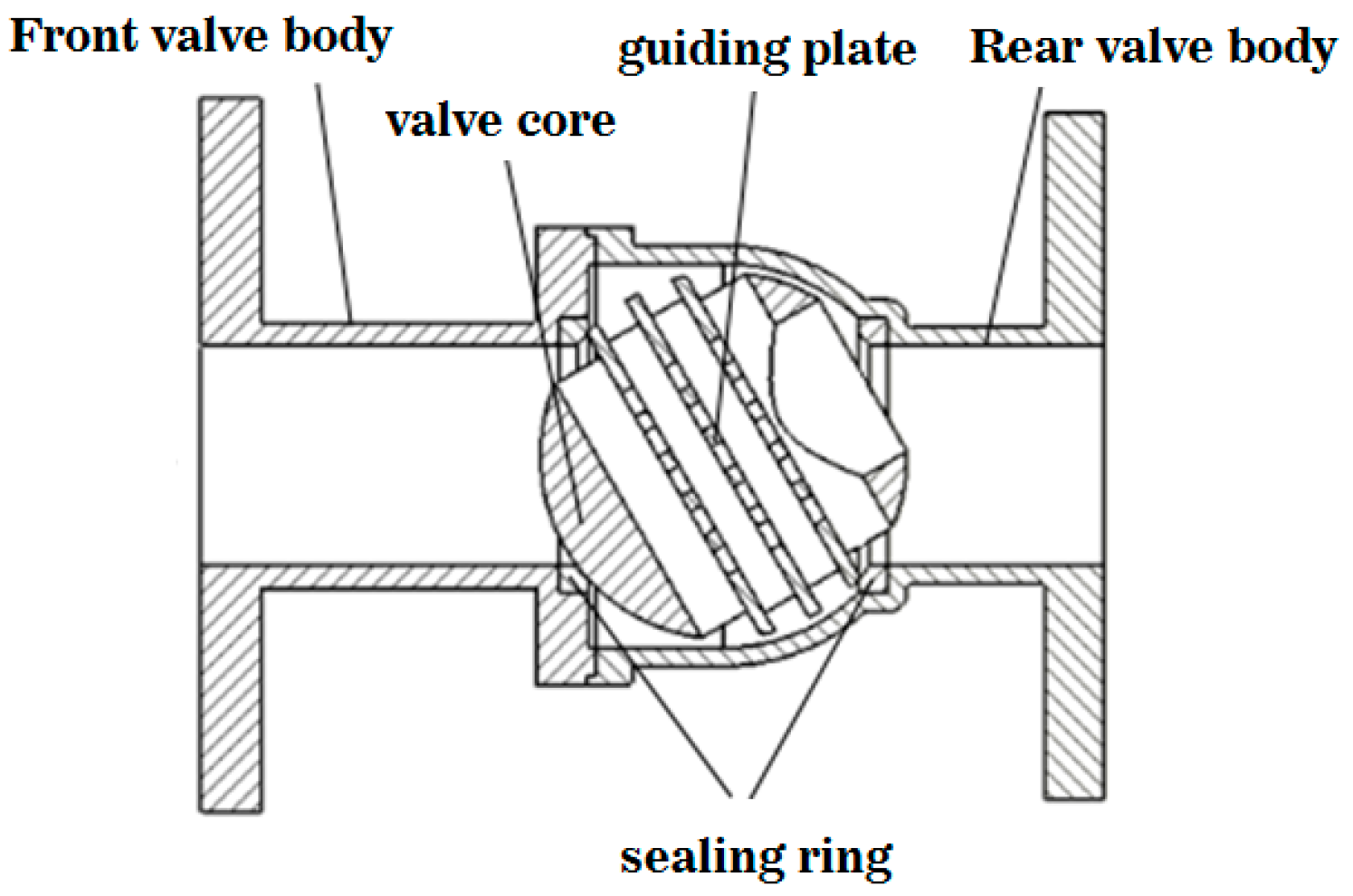


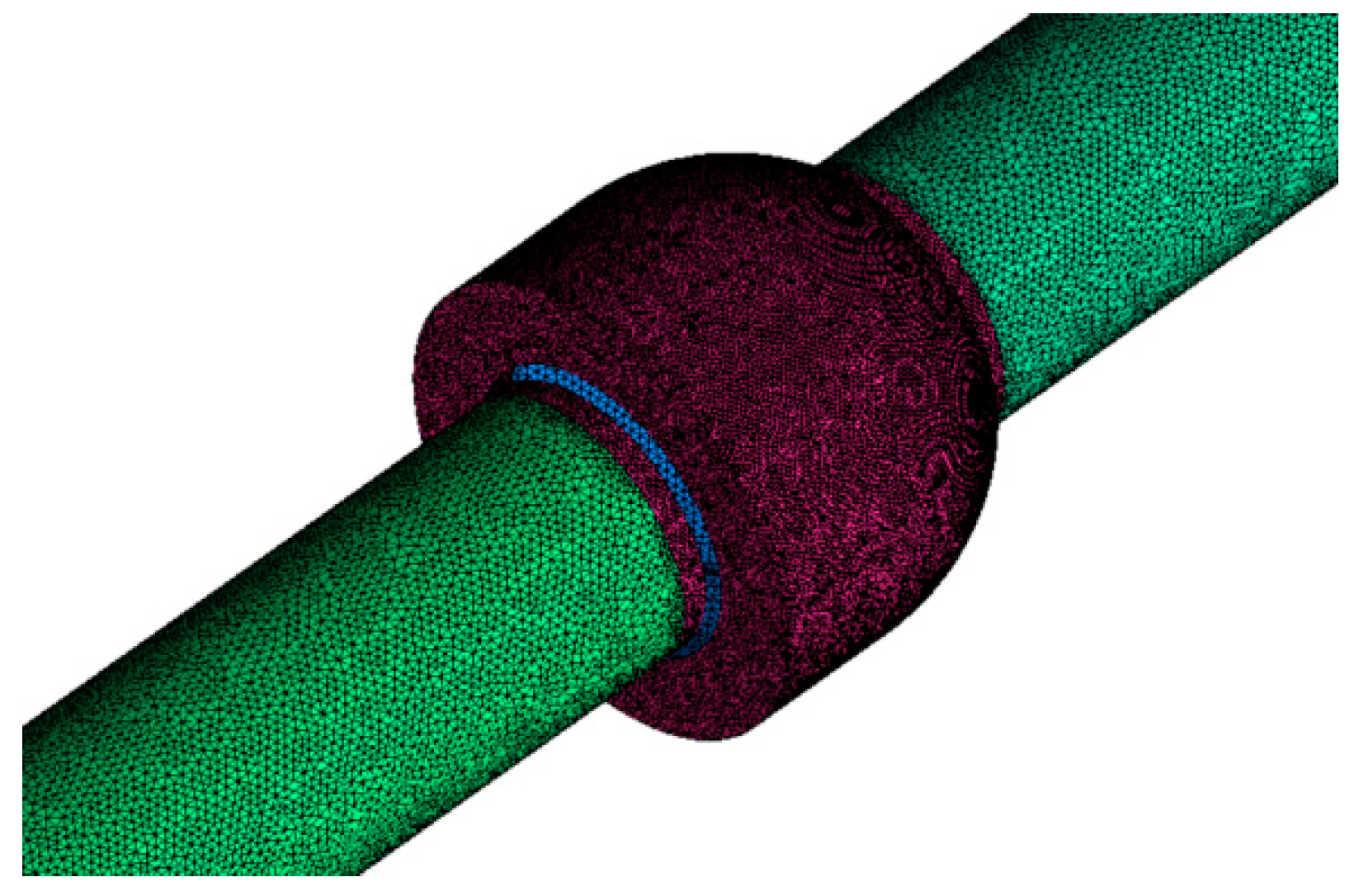

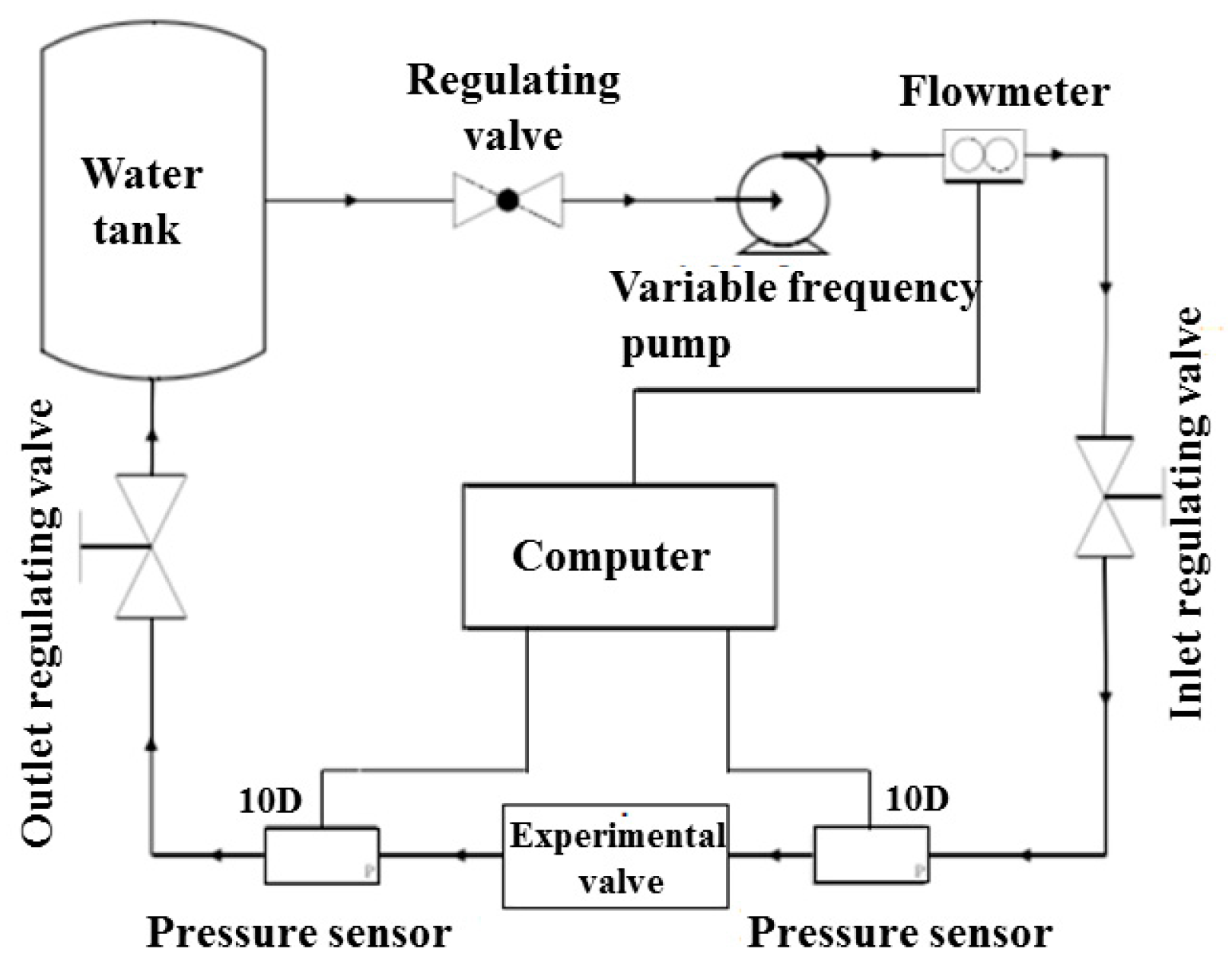


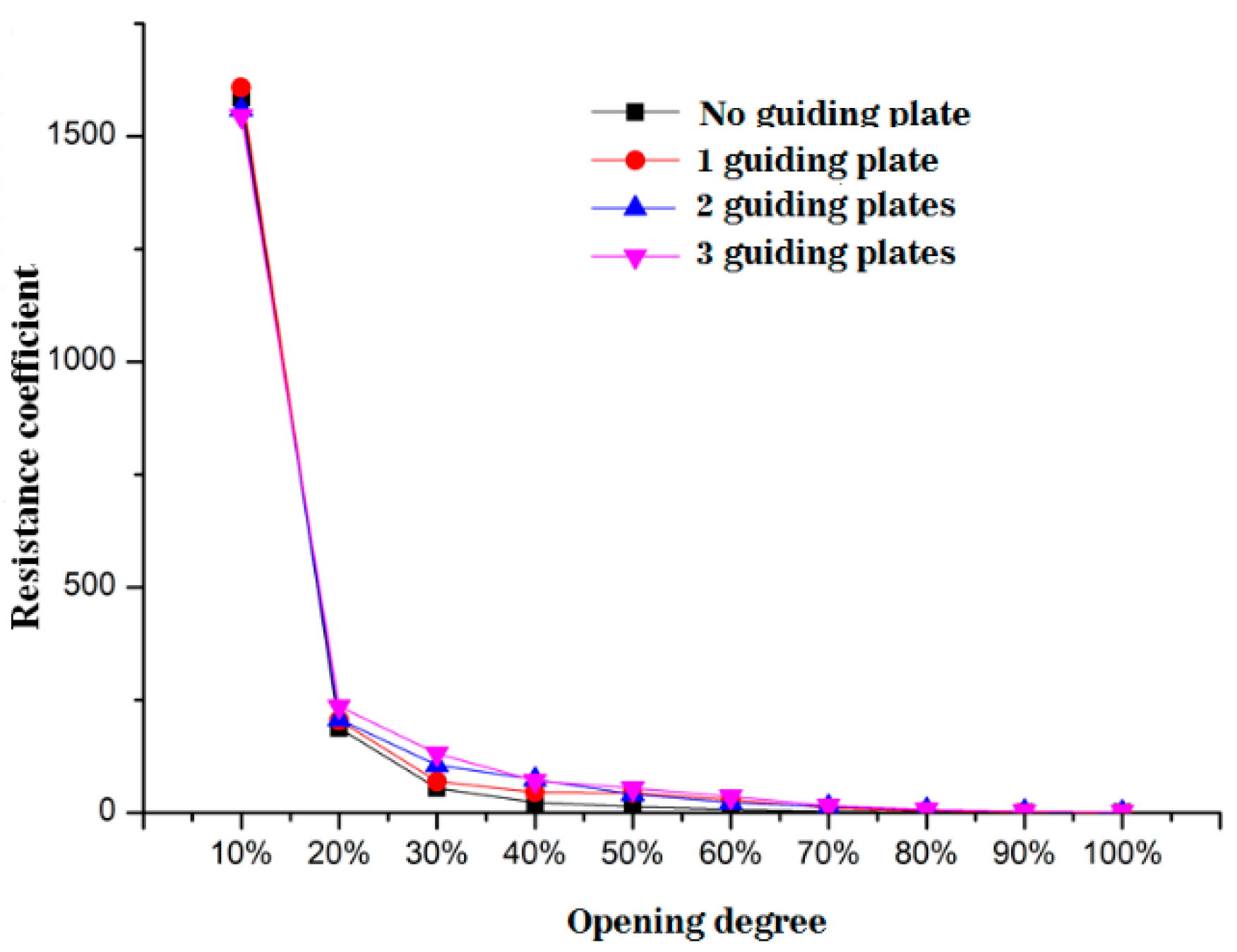

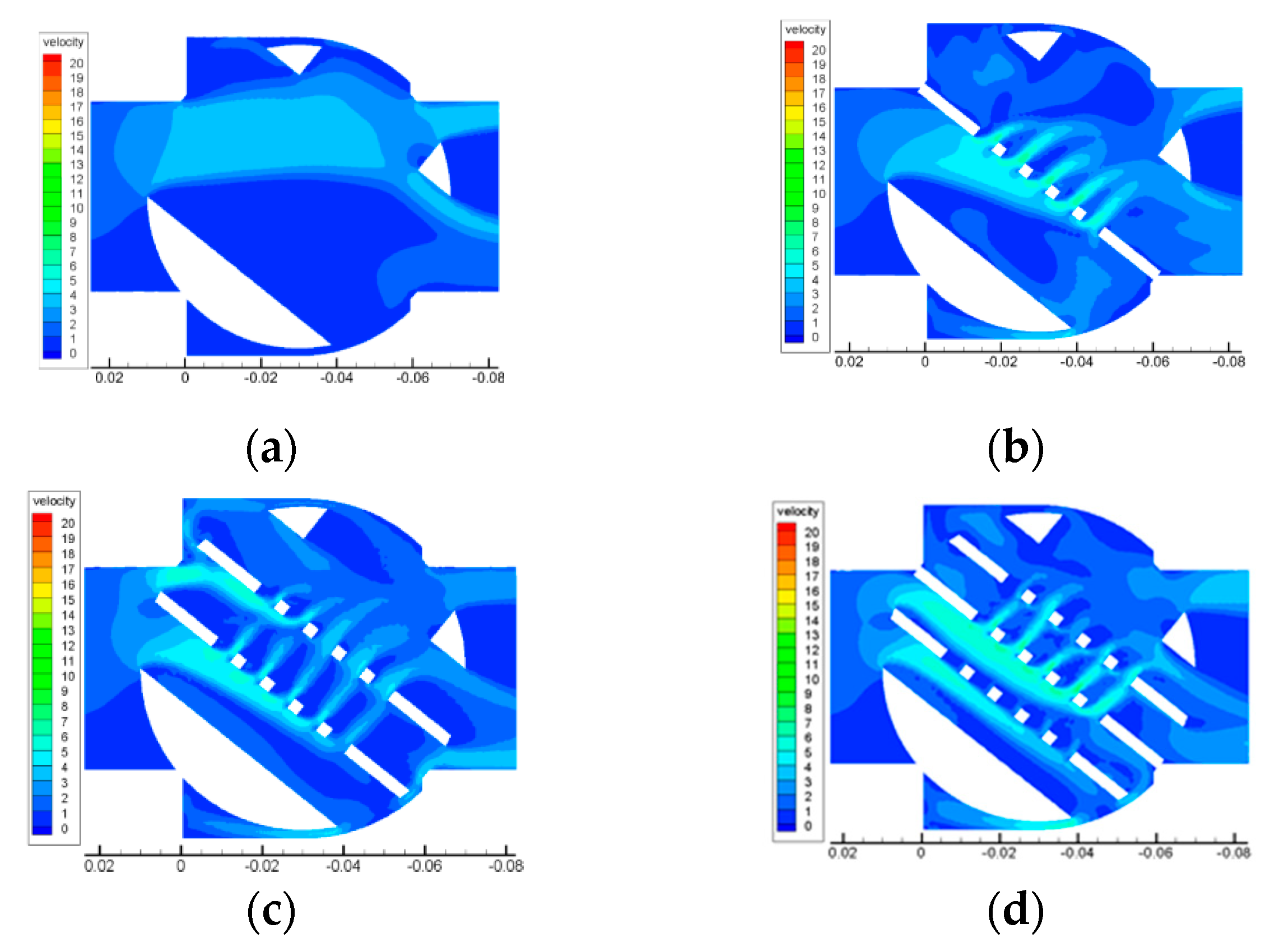
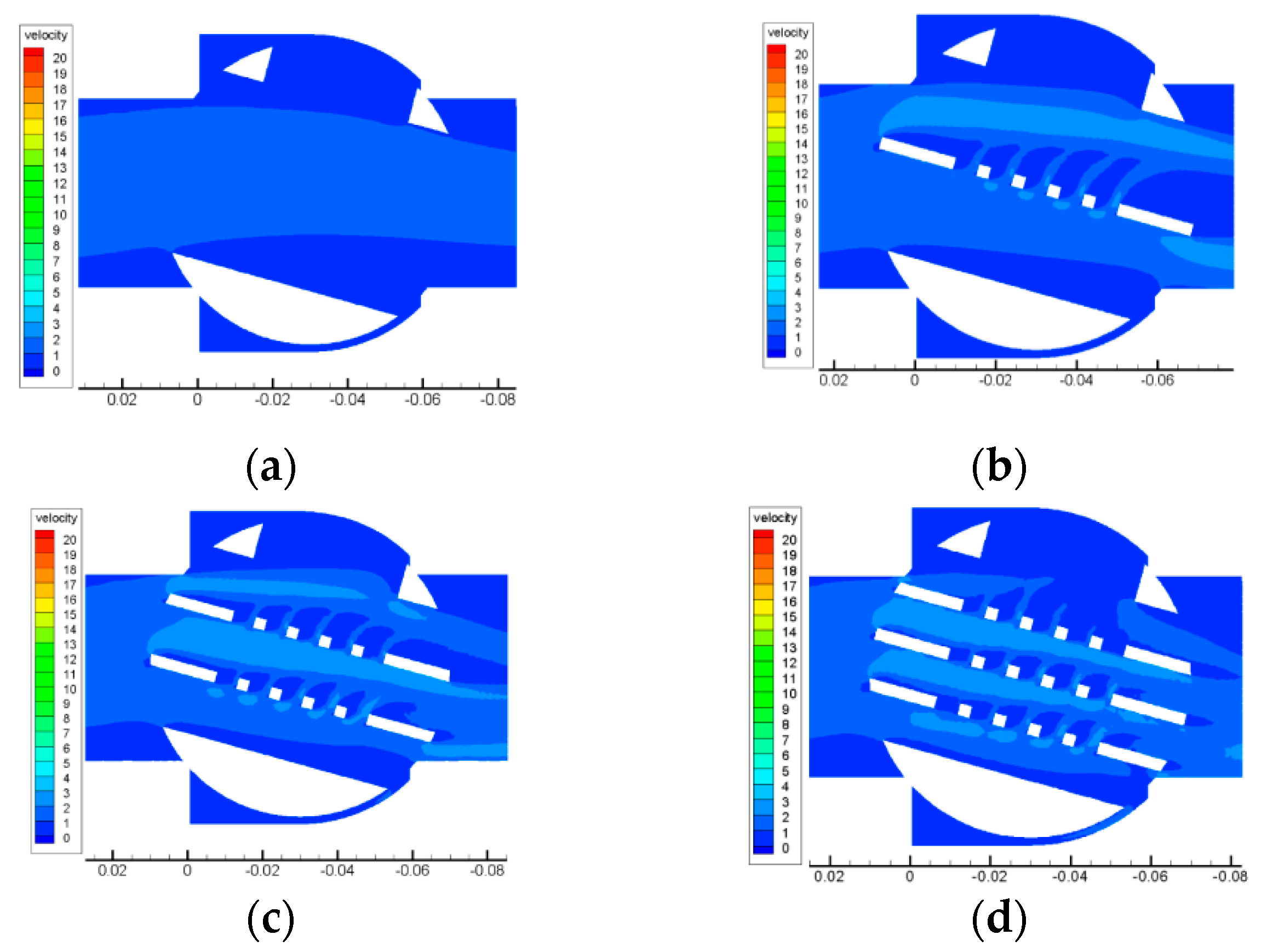

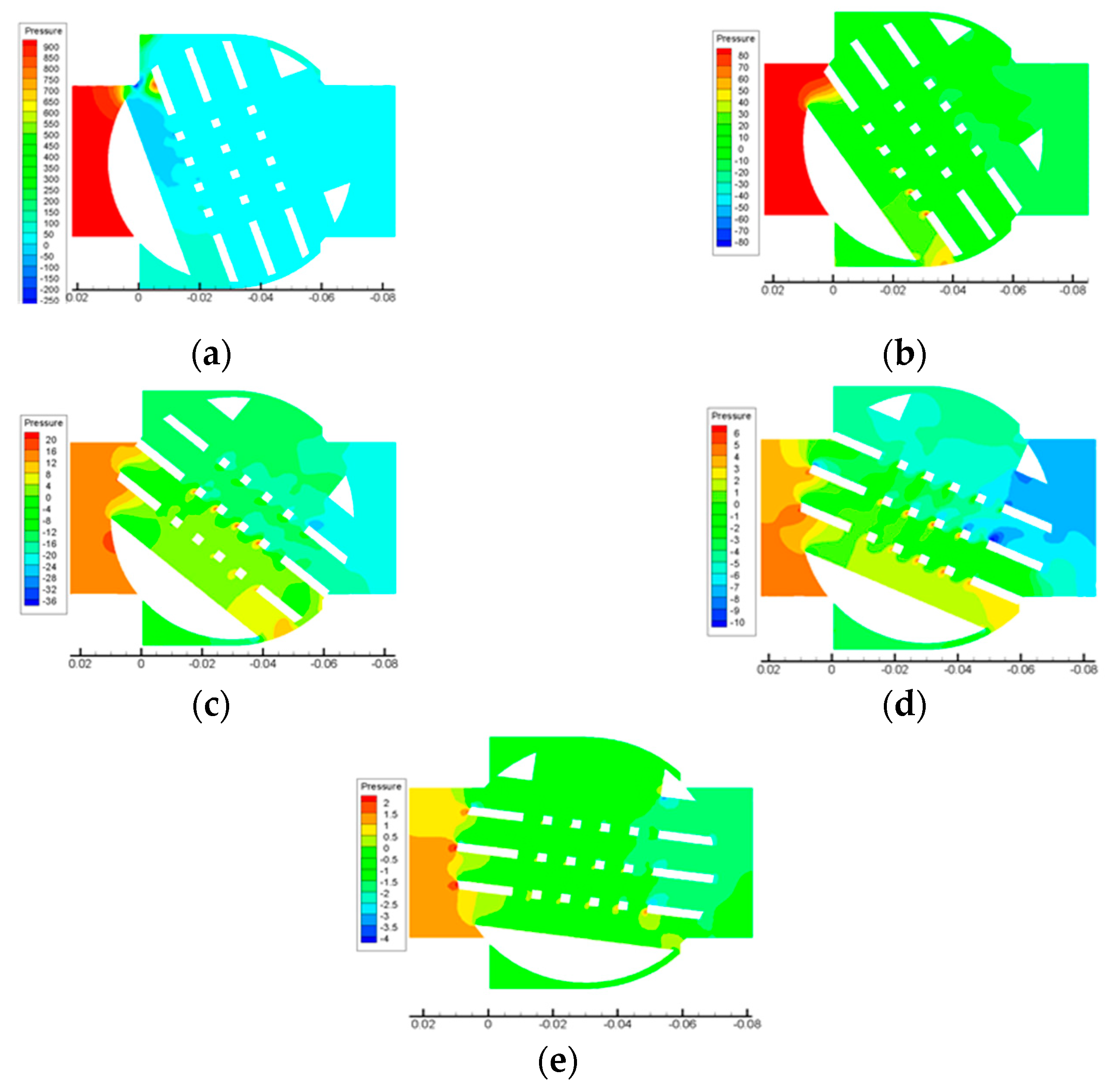
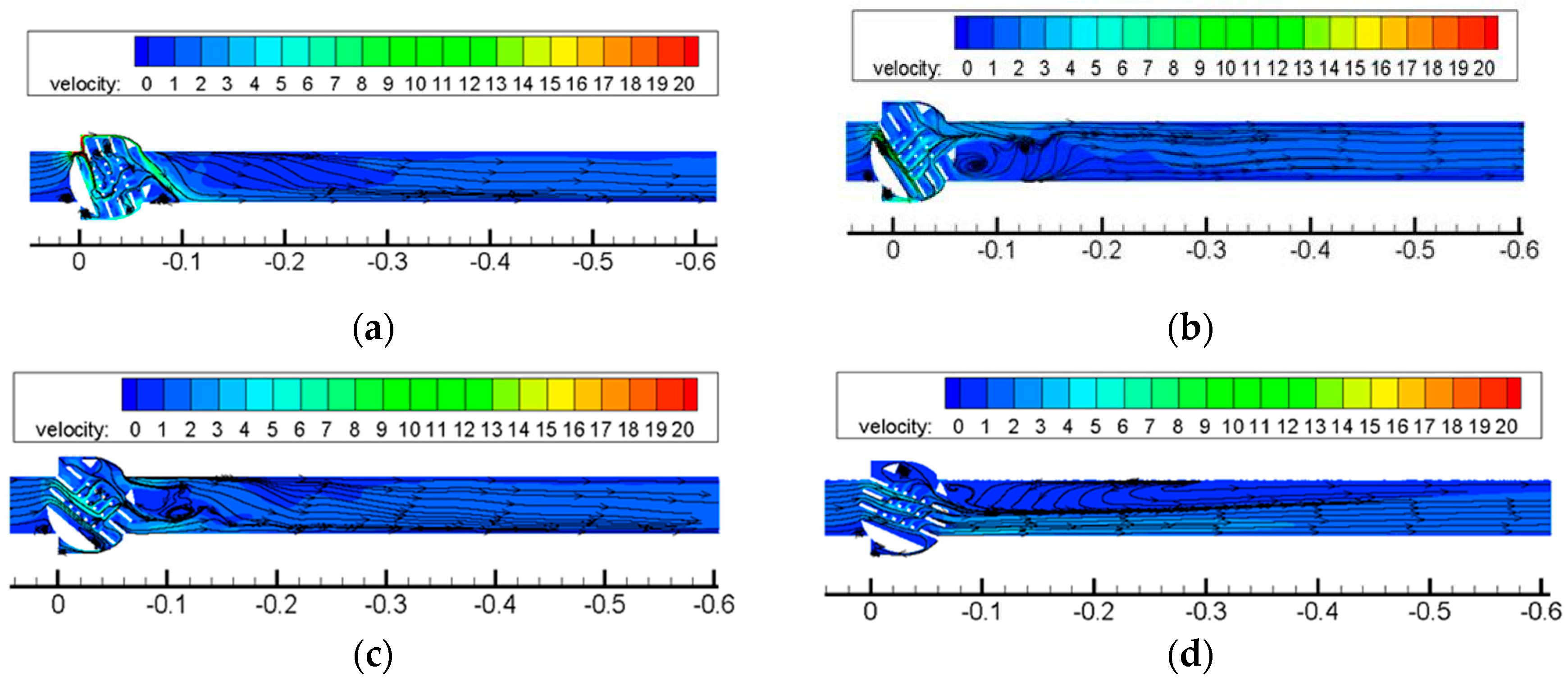

© 2020 by the authors. Licensee MDPI, Basel, Switzerland. This article is an open access article distributed under the terms and conditions of the Creative Commons Attribution (CC BY) license (http://creativecommons.org/licenses/by/4.0/).
Share and Cite
Wang, Y.; Zhu, C.; Zhang, G.; Wang, D.; Jiang, M.; Zhu, Z.; Lin, Z. Numerical Analysis to the Effect of Guiding Plate on Flow Characteristics in a Ball Valve. Processes 2020, 8, 69. https://doi.org/10.3390/pr8010069
Wang Y, Zhu C, Zhang G, Wang D, Jiang M, Zhu Z, Lin Z. Numerical Analysis to the Effect of Guiding Plate on Flow Characteristics in a Ball Valve. Processes. 2020; 8(1):69. https://doi.org/10.3390/pr8010069
Chicago/Turabian StyleWang, Yanping, Chaoning Zhu, Guang Zhang, Dejing Wang, Minghe Jiang, Zuchao Zhu, and Zhe Lin. 2020. "Numerical Analysis to the Effect of Guiding Plate on Flow Characteristics in a Ball Valve" Processes 8, no. 1: 69. https://doi.org/10.3390/pr8010069



